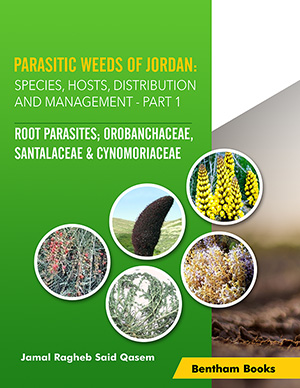Abstract
Weeds represent a major threat to agriculture in Jordan and cause great yield losses due to their
negative interference with crop plants (Qasem, 2003). Weeds affect crop plants through
competition, allelopathy, some through parasitism and may be in some cases through all at once.
Parasitic weeds are one group of a deep concern to local farmers and researchers and exert a real
danger to agriculture hence resources from water and nutrients are extremely limited considering
that 90% of the country’s area is a desert with drought and poor soil resources while the rest is
devoted to forestry and agriculture. These parasites reported from the country (Table 1) subsist on
the host species' root system or aerial vegetative parts. They can lead to severe growth damage
hence obtain food, water, and nutrients from host plants, resulting in yield failure and death of the
host plants under heavy infestation. Parasitic weeds may or may not have chlorophyll pigments
and thus are partially or completely dependent on host plants for food and/or water (Parker and
Riches, 1993). In Jordan, three families, including three genera, were reported to attack 34 wild
and cultivated species (Abu-Iramileh, 1979). In more recent studies, Qasem (2009, 2011) reported
eight parasitic genera of six plant families attacking many host species, among which 85 woody
plant species from 57 genera belong to 33 plant families. The distribution of parasites throughout
the country is shown in Fig. 3. The danger these parasites exert is mainly due to their difficulty to
control with available weed control methods, except by soil fumigation mainly using methyl
bromide, which has been banded a few years ago and its use is not economically feasible in the
open field or for application at a wide scale. In addition, the huge number of seeds these parasites
produce is accompanied by long seed viability and adaptability to disseminate by wind
(Orobanche, Cistanche, and Cynomorium), animals or birds (Loranthus, Viscum and Osyris), or
through crop infested seeds (Cuscuta, Orobanche and Thesium) add more complications to control
methods. The interrelationship between the parasites and their hosts and how parasites connect to
host plants through the absorptive organs (haustoria) is another means through which they
challenge control measures. Morphological and physiological similarities between the parasitic
species and their hosts and the ability of certain species to develop additional shoots from
epicortical roots (Loranthus spp.) or embedded haustoria (Cuscuta spp.), especially after damage
to or removal of the primary shoot (Viscum and Loranthus) hinder pruning and herbicides use as
common methods of control.






















